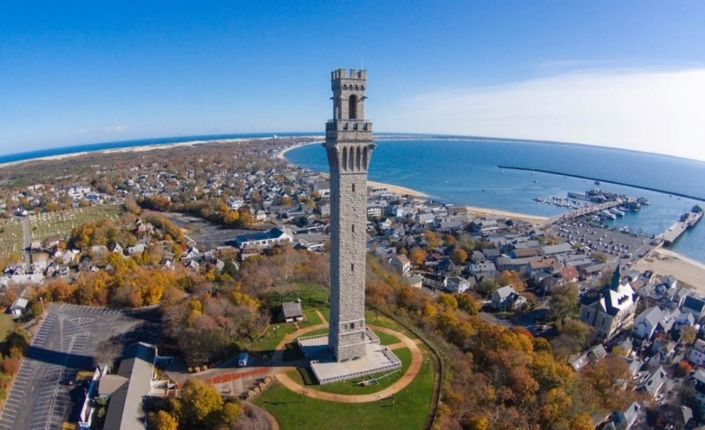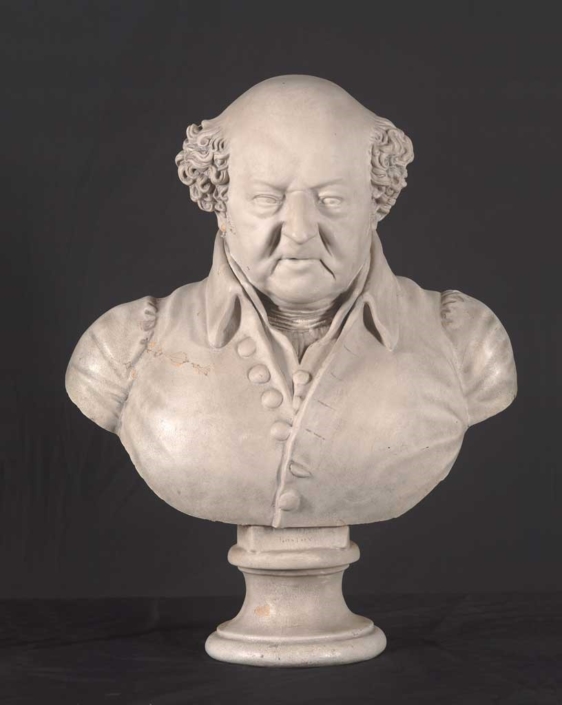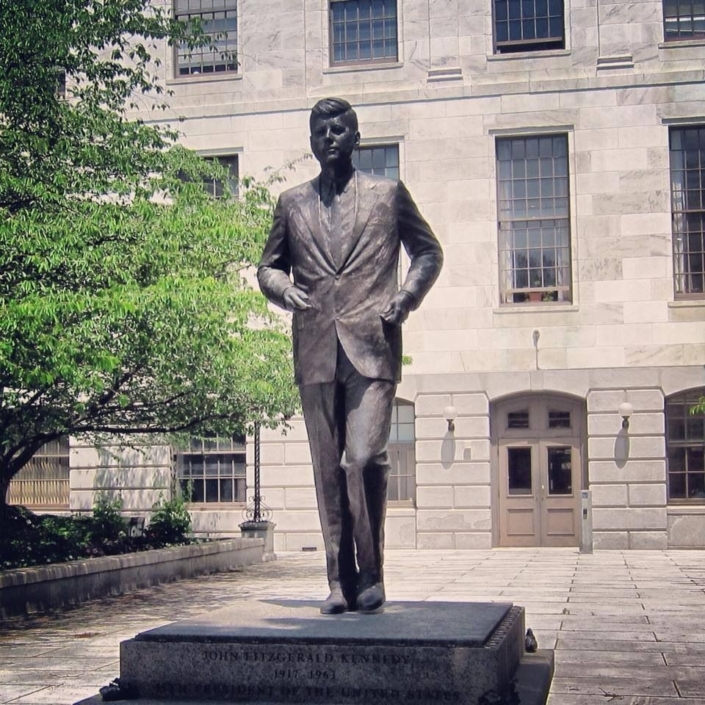“For we must consider that we shall be as a city upon a hill.
The eyes of all people are upon us…”
In Pioneer’s ongoing series of blogs here, here, here, and here on curricular resources for parents, families, and teachers during COVID-19, this one focuses on:
Introducing K-12 schoolchildren to Massachusetts monuments & memorials
“What you leave behind is not what is engraved in stone monuments, but what is woven into the lives of others,” the great Athenian statesman Pericles said in 430 B.C. Given the recent controversies, unrest, and the fact that wider understanding of public art is far too often neglected in K-12 education, we’re offering a variety of links about monuments, memorials, and statues across Massachusetts for parents, teachers, and schoolchildren to explore and visit, including the following:

The Sacred Cod of Massachusetts, State House, Boston, MA
“The Sacred Cod is a four-foot eleven-inch carved-wood effigy of an Atlantic codfish, "painted to the life", hanging in the House of Representatives chamber of Boston's Massachusetts State House – "a memorial of the importance of the Cod-Fishery to the welfare of this Commonwealth" (i.e. Massachusetts, of which cod is officially the "historic and continuing symbol").”

Massasoit Statue, Plymouth, MA
“Massasoit Sachem or Ousamequin was the sachem or leader of the Wampanoag confederacy. Massasoit means Great Sachem. Massasoit's people had been seriously weakened by a series of epidemics and were vulnerable to attacks by the Narragansetts, and he formed an alliance with the colonists at Plymouth Colony for defense against them. It was through his assistance that the Plymouth Colony avoided starvation during the early years.”

Pilgrim Monument, Provincetown, MA
“The Pilgrim Monument in Provincetown, Massachusetts, was built between 1907 and 1910 to commemorate the first landfall of the Pilgrims in 1620 and the signing of the Mayflower Compact in Provincetown Harbor. This 252-foot-7 1?2-inch-tall campanile is the tallest all-granite structure in the United States and is part of the Provincetown Historic District.”

The Puritan, Springfield, MA
“The Puritan is a bronze statue by sculptor Augustus St. Gaudens in Springfield, Massachusetts, United States, which became so popular it was reproduced for over 20 other cities, museums, universities, and private collectors around the world, and later became an official symbol of the city, emblazoned on its municipal flag. Originally designed to be part of Stearns Square, since 1899 the statue has stood at the corner of Chestnut and State Street next to The Quadrangle.”

Statue of Anne Hutchinson, State House, Boston
“Anne Hutchinson was a Puritan spiritual advisor, religious reformer, and an important participant in the Antinomian Controversy which shook the infant Massachusetts Bay Colony from 1636 to 1638. Her strong religious convictions were at odds with the established Puritan clergy in the Boston area and her popularity and charisma helped create a theological schism that threatened to destroy the Puritans' religious community in New England. She was eventually tried and convicted, then banished from the colony with many of her supporters… A statue of Anne Hutchinson by Cyrus Edwin Dallin is installed outside the Massachusetts State House, in Boston, Massachusetts.”

The Salem Witch Trials Memorial, Salem, MA
“In 1692, 14 women and 6 men were accused of being witches, were tried, convicted, and executed. Executions took place on June 10, July 19, August 19, September 19 and September 22, 1692. To this day, the events of 1692 are used as a yardstick to measure the depth of civility and due process in our society.”

The Minute Man, Concord, MA
“The Minute Man is an 1874 sculpture by Daniel Chester French located in Minute Man National Historical Park in Concord, Massachusetts. It was created between 1871 and 1874 after extensive research, and originally intended to be made of stone. The medium was switched to bronze and it was cast from 10 Civil War-era cannons appropriated by Congress.”

James Otis, Jr. & Mercy Otis Warren, Barnstable/Cape Cod, MA
“James Otis, Jr. was an American lawyer, political activist, pamphleteer, and legislator in Boston, a member of the Massachusetts provincial assembly, and an early advocate of the Patriot views against the policy of Parliament which led to the American Revolution. His well-known catchphrase "Taxation without Representation is tyranny" became the basic Patriot position…” “Mercy Otis Warren was a political writer and propagandist of the American Revolution. During the years before the American Revolution, Warren published poems and plays that attacked royal authority in Massachusetts and urged colonists to resist British infringements on colonial rights and liberties. She was married to James Warren, who was likewise heavily active in the independence movement.”

The Boston Women’s Memorial, Commonwealth Ave., Boston
“The Boston Women's Memorial is a trio of sculptures on the Commonwealth Avenue Mall in Boston, Massachusetts, commemorating the lives of [poet] Phillis Wheatley, [founding mother] Abigail Adams, and [abolitionist and suffragist] Lucy Stone.”

Equestrian statue of Paul Revere, the North End, Boston
“A statue of Paul Revere by Cyrus Edwin Dallin is installed in Boston's Paul Revere Mall near the Old North Church in the U.S. state of Massachusetts.”

John Adams, the Boston Athenæum, MA
“In February 1818 the Massachusetts state legislature passed a resolution to commission a marble bust of former president John Adams for Faneuil Hall in Boston. Typical of members of such bodies, the legislators had second thoughts, however, and one week later voted to delay the project indefinitely… Prominent Bostonians lent their support and a public subscription, limited to donations of no more than two dollars per donor, was quickly fulfilled with the help of 215 persons. In March 1818, a committee representing the subscribers wrote to the eighty-two-year-old Adams to ask for his cooperation, expressing their “desire of transmitting to our Children the Features of the Man, whose patriotic energies were so strenuously exerted for the Independence of our common Country.”

Statue of Alexander Hamilton, Commonwealth Ave., Boston
“A statue of Alexander Hamilton by William Rimmer is installed along Commonwealth Avenue, between Arlington and Berkeley Streets, in Boston, Massachusetts, United States. The 1864–1865 granite statue rests on a granite base. The base has three relief portrait busts depicting Hamilton, John Jay, and George Washington.”

The Whaleman Statue & Seamen’s Bethel Cenotaphs, New Bedford, MA
“The Whaleman was unveiled Jun 20, 1913 on Library Square. This statue of the boat-steerer set up in granite and bronze was erected in remembrance of the energy and fortitude, the toil and enterprise of the men who laid the foundation of the prosperity of this community. It is a tribute to the men who faced dangers, who grappled with difficulties, and who achieved success.” “Built by the New Bedford Port Society, the Seaman’s Bethel was completed on May 2, 1832. It is a contributing property to the New Bedford Historic District, a National Historic Landmark. The names of New Bedford whalers killed, and later all area fishermen, are noted on the walls of the bethel [with cenotaphs].”

Boston Irish Famine Memorial, Boston, MA
“The Boston Irish Famine Memorial is a memorial park located on a plaza between Washington Street and School Street in Boston, Massachusetts. The park contains two groups of statues to contrast an Irish family suffering during the Great Famine of 1845–1852 with a prosperous family that had emigrated to America. Funded by a trust led by Boston businessman Thomas Flatley, the park was opened in 1998.”

Homage to Women, Lowell, MA
“The Lowell mill girls were young female workers who came to work in industrial corporations in Lowell, Massachusetts, during the Industrial Revolution in the United States. The workers initially recruited by the corporations were daughters of New England farmers, typically between the ages of 15 and 35. By 1840, at the height of the Textile Revolution, the Lowell textile mills had recruited over 8,000 workers, with women making up nearly three-quarters of the mill workforce…” “Homage to Women by Mico Kaufman stands in a small shaded park on Market St. in Lowell, MA. The statue is part of the Lowell National Historical Park, which celebrates the textile industry that was founded in the mills along the Merrimack River.”

Nathaniel Hawthorne Statue, Salem, MA
“The Nathaniel Hawthorne Statue was designed by American sculptor Bela Lyon Pratt in 1916 and was installed on Hawthorne Boulevard in 1925. Pratt was an American sculptor whose works can be seen at the Library of Congress in Washington D.C. and in Boston at the Opera House, in front of the Boston Public Library and in the Boston Public Garden.”

Frederick Douglass, Faneuil Hall, Boston, MA
“Frederick Douglass was an American social reformer, abolitionist, orator, writer, and statesman. After escaping from slavery in Maryland, he became a national leader of the abolitionist movement in Massachusetts and New York, gaining note for his oratory and incisive antislavery writings.”

Sojourner Truth Memorial Statue, Florence,
“Sojourner Truth, a former slave who lived in Florence, MA in the mid-1800s, was a nationally known advocate for equality and justice…The site for the Sojourner Truth memorial statue is a former small city park at the corner of Pine and Park Streets in Florence. The city donated the site for the statue in November 2001.”

Memorial to Robert Gould Shaw & the Massachusetts 54th Regiment, Boston Common/Beacon Hill, Boston, MA
“The Memorial to Robert Gould Shaw and the Massachusetts 54th Regiment is a bronze relief sculpture by Augustus Saint-Gaudens opposite 24 Beacon Street, Boston (at the edge of the Boston Common). It depicts Colonel Robert Gould Shaw leading members of the 54th Regiment Massachusetts Volunteer Infantry as it marched down Beacon Street on May 28, 1863 to depart the city to fight in the South. The sculpture was unveiled on May 31, 1897. This is the first civic monument to pay homage to the heroism of African-American soldiers.”

Gloucester Fisherman’s Memorial, Gloucester, MA
“Gloucester Fisherman's Memorial (also known as: "Man at the Wheel" statue or "Fishermen's Memorial Cenotaph") is a historic memorial cenotaph sculpture on South Stacy Boulevard, near entrance of Stacy Esplanade in Gloucester, Massachusetts, built in 1925.”

Calvin Coolidge Memorial Bridge, Northampton, MA
“Calvin Coolidge was an American politician and lawyer who served as the 30th president of the United States from 1923 to 1929. A Republican lawyer from New England, born in Vermont, Coolidge worked his way up the ladder of Massachusetts state politics, eventually becoming governor of Massachusetts… The Calvin Coolidge Memorial Bridge is a five-span, single intersection Warren deck truss bridge with distinctive design on its granite-faced abutment pylons. Art Deco ornamentation on the pylons includes carved eagles and incised carved lettering.”

Statues of James Michael Curley, Boston, MA
“James Michael Curley was an American Democratic Party politician from Boston, Massachusetts. One of the most colorful figures in Massachusetts politics in the first half of the 20th century, Curley served four terms as Mayor of Boston, Massachusetts, including part of one while in prison… Two statues of James Michael Curley are installed at the intersection of Congress and North streets, in Boston, Massachusetts, United States. The bronze double portrait was created by Lloyd Lillie during 1979–1980, and dedicated on September 18, 1980.”

New England Holocaust Memorial, Boston, MA
“The New England Holocaust Memorial in Boston, Massachusetts is dedicated to the Jewish people who were murdered by Nazi Germany during the Holocaust… Founded by Stephan Ross, a Holocaust survivor, and erected in 1995, the memorial consists of six glass towers under which a visitor may walk. Engraved on the outside walls of each tower are groups of numbers representing the six million Jews murdered in the Holocaust. Inscribed on the inner walls are quotes from survivors of each camp. Underneath the towers, steam rises up through metal grates from a dark floor with twinkling lights on it.”

Statues of Bill Russell & Red Auerbach, Boston, MA
“Bill Russell is an American former professional basketball player who played center for the Boston Celtics of the National Basketball Association (NBA) from 1956 to 1969. A five-time NBA Most Valuable Player and a 12-time All-Star, he was the centerpiece of the Celtics dynasty that won eleven NBA championships during his 13-year career… A statue of former professional basketball player Bill Russell by Ann Hirsch is installed outside Boston's City Hall, in the U.S. state of Massachusetts. The bronze sculpture was unveiled in 2013… A statue of long-time Boston Celtics coach Red Auerbach by Lloyd Lillie is installed outside Quincy Market at Faneuil Hall, in Boston, Massachusetts, United States.”

Statue of John F. Kennedy, State House, Boston, MA
“John Fitzgerald Kennedy, often referred to by his initials JFK and Jack, was an American politician who served as the 35th president of the United States from January 1961 until his assassination in November 1963… A statue of John F. Kennedy by Isabel McIlvain is installed outside the Massachusetts State House in Boston, Massachusetts, United States.”

Click here to learn more.
More information about the buildings here.





